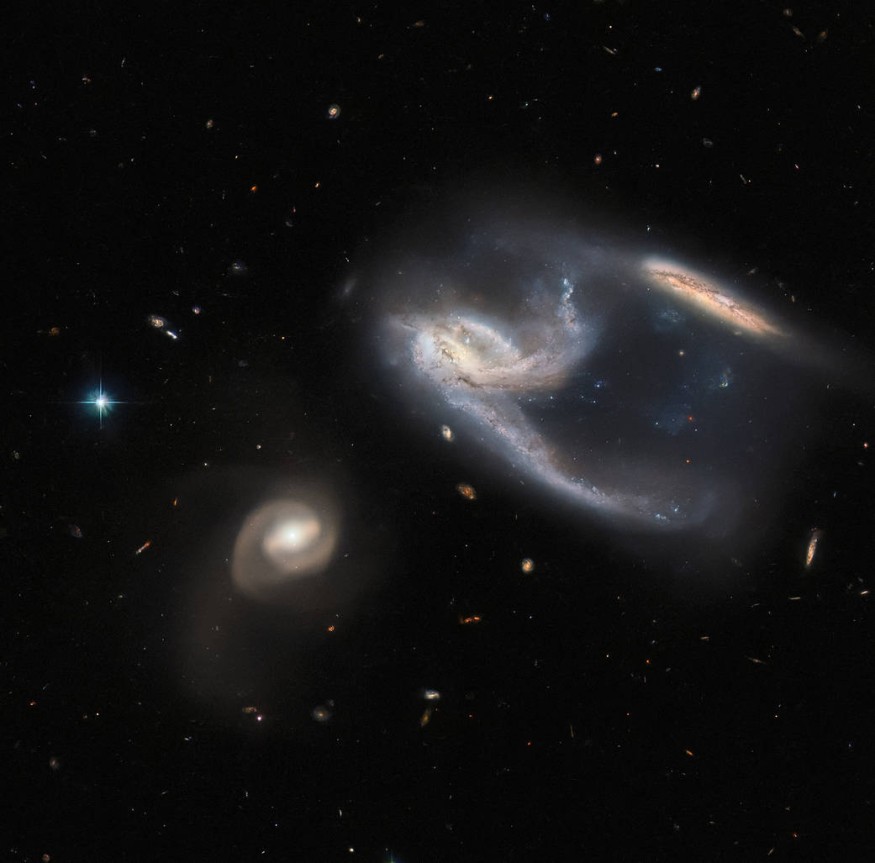In a picture released to the public on Saturday, NASA's Hubble Space Telescope caught one such breathtaking sight. The galaxies, collectively known as NGC 7764A, are located in the Phoenix constellation, approximately 425 million light-years away from Earth.
According to Devdiscourse, the two galaxies in the image's upper right appear to interact to produce a shape that resembles the USS Enterprise, a spacecraft from the Star Trek media franchise, from our Solar System's perspective.
The vast trails of stars and gas stretching from the two galaxies both appear to have been struck at high speed, thrown into disorder by the bowling-ball-shaped galaxy to the image's lower left.

NASA Hubble Space Telescope Captures Galaxies Seemingly Colliding With One Another
While it appears like the two galaxies in the top right hand have collided, ESA claimed per Republic World that this is not the case. NGC 7764A1, NGC 7764A2, and NGC 7764A3 are the three galaxies shown in the image, and they are collectively known as NGC 7764A.
SciNews said English astronomer John Herschel found the biggest of the three galaxies, NGC 7764A1 (also known as ESO 293-8, Aguero 83, and LEDA 72762), on October 4, 1836.
ALSO READ : NASA Hubble Space Telescope Captures Stunning Titanic Galaxy 115 Million Light-Years Away
The vast trails of stars and gas stretching from both entities provide the sense of contact between the upper two galaxies. However, NASA said that interactions between galaxies take place over extremely long time scales, and galaxies seldom collide head-on.
📷 This NASA/ESA @HUBBLE_space image shows a group of three galaxies, collectively known as NGC 7764A (not to be confused with an entirely different galaxy called NGC 7764). Individually, these three are called NGC 7764A1, NGC 7764A2 and NGC 7764A3 👉 https://t.co/4UzSD4Bmch pic.twitter.com/FSQuvFc8XD
— European Space Agency (@esa) January 24, 2022
This year, NASA had previously released a similar picture, which looked to show galaxy NGC 105 colliding with another galaxy far distant. However, the space agency pointed out that this was an optical illusion.
About NASA Hubble Space Telescope's ACS and WFC3
Hubble employed its Advanced Camera for Surveys and its Wide Field Camera 3 to collect sky photographs in visible and red wavelengths. Hubble got both cameras as upgrades, News9Live said.
The Wide Field Camera 3 was deployed in 2009, while the Advanced Camera for Surveys was installed in 2002. Even though its partner, the James Webb Space Telescope, is projected to allow astronomers to picture even more distant galaxies and discover objects shrouded by dust using infrared wavelengths, Hubble is expected to continue imaging the heavens in visible and ultraviolet wavelengths.
In 1990, the space shuttle Discovery launched and deployed the NASA/ESA Hubble Space Telescope. The project is a joint venture between the European Space Agency and NASA, the United States' space agency. The observatory has reached a milestone of one billion seconds in orbit.
Check out more news and information on Space in Science Times.
© 2025 ScienceTimes.com All rights reserved. Do not reproduce without permission. The window to the world of Science Times.











